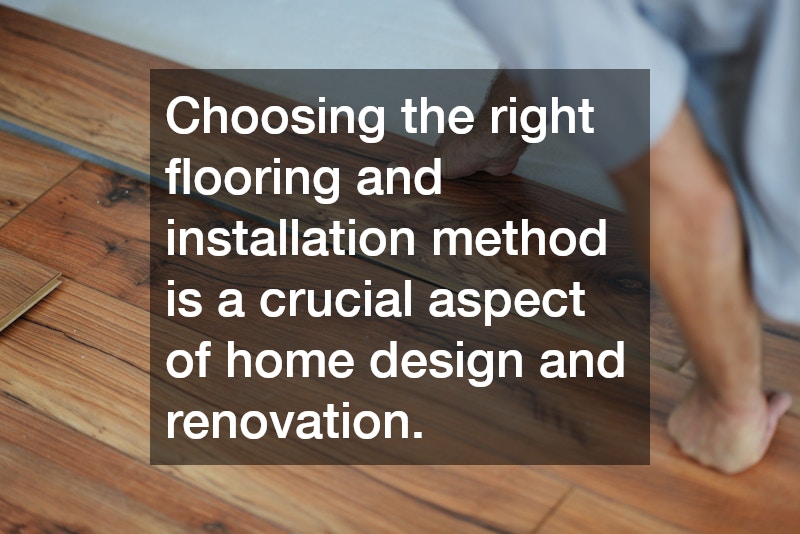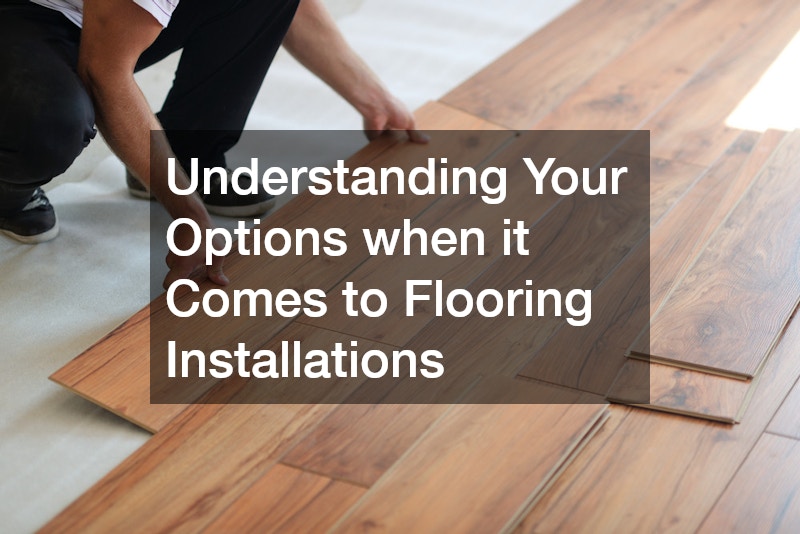Flooring installations can significantly enhance the aesthetic and functional aspects of your home. With numerous options available, it’s essential to understand the different types and installation methods to make an informed decision that suits your space and lifestyle. This guide delves into the various flooring materials and methods, helping you choose the best fit for your needs.
1. What are the different types of flooring materials available?
1.1. Hardwood Flooring
Explore the classic appeal and durability of hardwood flooring, including types like oak, maple, and cherry. Hardwood floors offer timeless beauty and can be an excellent investment for your home. They are known for their longevity and can add significant value to your property, making them a popular choice among homeowners.
Hardwood is available in various grain patterns and tones, allowing you to select an option that complements your decor. It also ages gracefully, developing a beautiful patina over time. Despite being a more expensive choice, its durability and charm often justify the cost for many homeowners.
1.2. Laminate Flooring
Understand the cost-effective and versatile nature of laminate flooring, resembling wood or stone. Laminate is an excellent choice for those seeking a wood look at a fraction of the price. Its multi-layer synthetic construction is designed to withstand wear and tear, making it suitable for high-traffic areas.
Laminate offers a wide variety of appearances, from mimicking exotic hardwoods to rustic stones, providing versatility in design. Unlike hardwood, laminate is resistant to scratches and dents, making it ideal for families with pets and children. Installation is often simpler with laminate, thanks to its click-together planks.
1.3. Vinyl and Linoleum
Discover the differences between vinyl and linoleum flooring, focusing on their water resistance and easy maintenance. Vinyl is known for its versatility and affordability, with designs ranging from realistic wood grains to intricate tile patterns. Linoleum, while similar in appearance to vinyl, is made from natural materials, offering an eco-friendly alternative.
Both vinyl and linoleum are praised for their comfort underfoot and resilience to stains and spills, making them perfect for kitchens and bathrooms. Their water resistance is a significant feature, as they can withstand moisture without warping or damage. Routine cleaning with a damp mop is typically sufficient for maintenance, adding to their convenience.
2. How to choose the right flooring installation method?
2.1. Nail Down and Staple Down Methods
Learn about these installation techniques primarily used for hardwood floors and their pros and cons. The nail-down method involves attaching the flooring directly to the subfloor, providing a stable and secure fit. This method is ideal for solid hardwood and enhances the floor’s firmness.
The staple-down approach, similar to the nail-down technique, uses staples instead of nails, offering a more secure grip. Both methods require precise execution and are usually best handled by professionals. As they involve fixing the floor permanently, future replacement might involve more effort and cost.
2.2. Floating Floor Method
Examine the advantages of the floating floor installation method, commonly used for laminate and engineered wood. This method involves joining planks together, allowing them to “float” over the subfloor without the use of nails or glue. It accommodates natural expansion and contraction, reducing the risk of warping.
The floating floor method is particularly beneficial for spaces where moisture might be a concern, as it reduces direct contact with the subfloor. Additionally, its straightforward installation process makes it a popular DIY choice. Laminate and engineered wood floors are well-suited for this method, offering both beauty and practicality.
2.3. Glue Down Method
Assess the benefits and appropriate scenarios for using the glue-down method, ideal for vinyl and engineered flooring. This method provides a firm bond between the floor and subfloor, ensuring stability and reducing noise. It is ideal for both residential and commercial spaces that require durable surfaces.
Though more time-consuming than some other methods, the glue-down approach secures the floor firmly, reducing movement and increasing durability. This method is particularly advantageous for thinner flooring options like vinyl, as it prevents the floor from shifting over time. However, thorough subfloor preparation is crucial to ensure effective adhesion.
Choosing the right flooring and installation method is a crucial aspect of home design and renovation. By understanding the various materials and techniques, you can make an informed decision that aligns with your aesthetic preferences and practical needs. Consider consulting with professionals to further explore your options and ensure a successful flooring installation.
.
Flooring installations can significantly enhance the aesthetic and functional aspects of your home. With numerous options available, it’s essential to understand the different types and installation methods to make an informed decision that suits your space and lifestyle. This guide delves into the various flooring materials and methods, helping you choose the best fit for your needs.
1. What are the different types of flooring materials available?
1.1. Hardwood Flooring
Explore the classic appeal and durability of hardwood flooring, including types like oak, maple, and cherry. Hardwood floors offer timeless beauty and can be an excellent investment for your home. They are known for their longevity and can add significant value to your property, making them a popular choice among homeowners.
Hardwood is available in various grain patterns and tones, allowing you to select an option that complements your decor. It also ages gracefully, developing a beautiful patina over time. Despite being a more expensive choice, its durability and charm often justify the cost for many homeowners.
1.2. Laminate Flooring
Understand the cost-effective and versatile nature of laminate flooring, resembling wood or stone. Laminate is an excellent choice for those seeking a wood look at a fraction of the price. Its multi-layer synthetic construction is designed to withstand wear and tear, making it suitable for high-traffic areas.
Laminate offers a wide variety of appearances, from mimicking exotic hardwoods to rustic stones, providing versatility in design. Unlike hardwood, laminate is resistant to scratches and dents, making it ideal for families with pets and children. Installation is often simpler with laminate, thanks to its click-together planks.
1.3. Vinyl and Linoleum
Discover the differences between vinyl and linoleum flooring, focusing on their water resistance and easy maintenance. Vinyl is known for its versatility and affordability, with designs ranging from realistic wood grains to intricate tile patterns. Linoleum, while similar in appearance to vinyl, is made from natural materials, offering an eco-friendly alternative.
Both vinyl and linoleum are praised for their comfort underfoot and resilience to stains and spills, making them perfect for kitchens and bathrooms. Their water resistance is a significant feature, as they can withstand moisture without warping or damage. Routine cleaning with a damp mop is typically sufficient for maintenance, adding to their convenience.
2. How to choose the right flooring installation method?
2.1. Nail Down and Staple Down Methods
Learn about these installation techniques primarily used for hardwood floors and their pros and cons. The nail-down method involves attaching the flooring directly to the subfloor, providing a stable and secure fit. This method is ideal for solid hardwood and enhances the floor’s firmness.
The staple-down approach, similar to the nail-down technique, uses staples instead of nails, offering a more secure grip. Both methods require precise execution and are usually best handled by professionals. As they involve fixing the floor permanently, future replacement might involve more effort and cost.
2.2. Floating Floor Method
Examine the advantages of the floating floor installation method, commonly used for laminate and engineered wood. This method involves joining planks together, allowing them to “float” over the subfloor without the use of nails or glue. It accommodates natural expansion and contraction, reducing the risk of warping.
The floating floor method is particularly beneficial for spaces where moisture might be a concern, as it reduces direct contact with the subfloor. Additionally, its straightforward installation process makes it a popular DIY choice. Laminate and engineered wood floors are well-suited for this method, offering both beauty and practicality.
2.3. Glue Down Method
Assess the benefits and appropriate scenarios for using the glue-down method, ideal for vinyl and engineered flooring. This method provides a firm bond between the floor and subfloor, ensuring stability and reducing noise. It is ideal for both residential and commercial spaces that require durable surfaces.
Though more time-consuming than some other methods, the glue-down approach secures the floor firmly, reducing movement and increasing durability. This method is particularly advantageous for thinner flooring options like vinyl, as it prevents the floor from shifting over time. However, thorough subfloor preparation is crucial to ensure effective adhesion.
Choosing the right flooring and installation method is a crucial aspect of home design and renovation. By understanding the various materials and techniques, you can make an informed decision that aligns with your aesthetic preferences and practical needs. Consider consulting with professionals to further explore your options and ensure a successful flooring installation.
.

